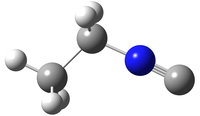Ethyl isocyanide, isocyanoethane
 | |
|---|---|
| Species tag | 055507 |
| Version | 1* |
| Date of Entry | May 2018 |
| Contributor | H. S. P. Müller |
|
The majority of the data were taken
from | |
| Lines Listed | 18963 |
| Frequency / GHz | < 1500 |
| Max. J | 118 |
| log STR0 | -8.0 |
| log STR1 | -6.0 |
| Isotope Corr. | -0.0 |
| Egy / (cm–1) | 0.0 |
| µa / D | 3.79 |
| µb / D | 1.31 |
| µc / D | |
| A | 27760.009 |
| B | 5117.292 |
| C | 4561.923 |
| Q(300.0) | 34562.8632 |
| Q(225.0) | 22427.8974 |
| Q(150.0) | 12197.4866 |
| Q(75.00) | 4310.0357 |
| Q(37.50) | 1524.5015 |
| Q(18.75) | 539.8958 |
| Q(9.375) | 191.5989 |
| Q(5.000) | 75.1311 |
| Q(2.725) | 30.5989 |
| detected in ISM/CSM | no |